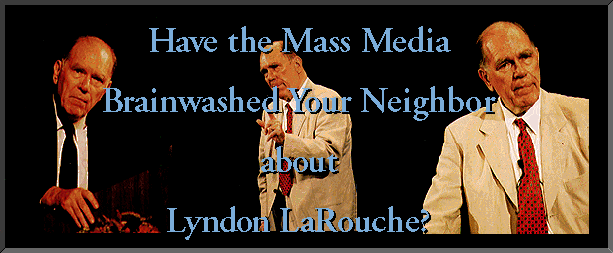

The railroading of Lyndon LaRouche and his associates to prison was set up by an illegal and unprecedented involuntary bankruptcy action--initiated by the same Justice Department prosecutors, and approved by the same federal judge, who later oversaw the frame-up criminal trial of LaRouche in Alexandria, Va.
Well before the bankruptcy action was taken, federal prosecutors realized that they could not carry out a successful prosecution of LaRouche unless they could cut off repayments of loans to persons who were political supporters of the LaRouche movement, and who had lent funds to publishing companies associated with the LaRouche political movement.
The involuntary bankruptcy--which made it illegal to repay these loans!--was the essential precondition for bringing criminal charges of conspiracy to commit mail fraud and wire fraud against LaRouche and his associates.
Never before in U.S. history had the government itself been the petitioner in an involuntary bankruptcy case. An involuntary bankruptcy is normally brought by three or more creditors of an insolvent business. In this case, the {only} petitioning creditor was the U.S. government--in the form of the U.S. Department of Justice, through U.S. Attorney Henry Hudson of the Eastern District of Virginia. And the companies were not insolvent.
That wasn't all. Simply filing a petition to put the companies into involuntary bankruptcy, would not have immediately shut them down and stopped payments. In the normal course of events, the companies would have been able to contest the petition in court, over a period on months or longer. So Hudson and the Justice Department had to do something much more drastic--which was something that no normal creditor could do.
They secretly went to the Bankruptcy Court on April 20, 1987, and obtained an order allowing the government to immediately go and shut down the companies. That evening, Hudson deployed FBI agents to surveil the offices of those companies. Early the next morning, U.S. Marshals seized the offices of the three companies and sealed them.
Hudson was able to carry this out as the result of an ex parte (one-sided) hearing, at which a federal bankruptcy judge signed a sealed order directing the appointment of trustees who were supposed to take over the companies. That was a sham: Hudson had no intention of allowing the trustees to operate the businesses. The companies--two publishers and a literature distribution company--were padlocked, never to reopen, and were barred by court order from conducting any business, including paying creditors such as lenders and political supporters. This procedure was then upheld by U.S. District Judge Albert V. Bryan, Jr.--who was later to preside over the criminal prosecution of LaRouche.
Two and one-half years later, the Bankruptcy Court dismissed the government's petitions, ruling that Hudson and his office had acted in ``objective bad faith'' and had conducted a ``constructive fraud on the court.'' But by that time, LaRouche and his co-defendants were already in federal prison.
How did it work? On day of the signing of the secret order directing the seizure and padlocking of the companies, the FBI sent out lists of LaRouche supporters and lenders to all FBI field offices, directing them to contact the lenders to recruit witnesses for the planned criminal case. The FBI teletype acknowledged that many of the lenders ``are still supporters of the organization and may not consider themselves a victim.'' The Justice Department/FBI strategy was to {turn them into victims,} by telling lenders that they would never get their money back--because the companies were bankrupt.
Thus, having created a pool of ``victims,'' the prosecutors selected a handful to be presented at the LaRouche show-trial. To top it off, Judge Bryan--the same judge who had approved the illegal seizure and shutdown of the companies--issued an order {prohibiting} the defense from telling the jury that they had been prevented {by the government} from paying back the loans.
With such an elaborate rigging of the trial, convictions were virtually a foregone conclusion.